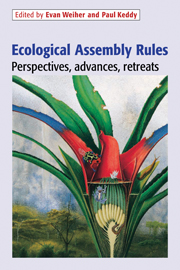Book contents
- Frontmatter
- Contents
- List of Contributors
- Introduction: The scope and goals of research on assembly rules
- Part I The search for meaningful patterns in species assemblages
- 1 The genesis and development of guild assembly rules
- 2 Ruling out a community assembly rule: the method of favored states
- 3 Community structure and assembly rules: confronting conceptual and statistical issues with data on desert rodents
- 4 Introduced avifaunas as natural experiments in community assembly
- 5 Assembly rules in plant communities
- 6 Assembly rules at different scales in plant and bird communities
- 7 Impact of language, history and choice of system on the study of assembly rules
- Part II Other perspectives on community assembly
- Index
6 - Assembly rules at different scales in plant and bird communities
Published online by Cambridge University Press: 04 September 2009
- Frontmatter
- Contents
- List of Contributors
- Introduction: The scope and goals of research on assembly rules
- Part I The search for meaningful patterns in species assemblages
- 1 The genesis and development of guild assembly rules
- 2 Ruling out a community assembly rule: the method of favored states
- 3 Community structure and assembly rules: confronting conceptual and statistical issues with data on desert rodents
- 4 Introduced avifaunas as natural experiments in community assembly
- 5 Assembly rules in plant communities
- 6 Assembly rules at different scales in plant and bird communities
- 7 Impact of language, history and choice of system on the study of assembly rules
- Part II Other perspectives on community assembly
- Index
Summary
Introduction: assembly rules, scale, purpose and application
One of the basic premises in ecology is that communities are composed of collections of species that are subsets of a larger pool of available species (e.g., Cody & Diamond, 1975; Diamond & Case, 1986), and that the composition of these subsets is governed, potentially at least, by ‘assembly rules’ (Diamond, 1985). In particular, and as originally envisaged by Diamond (1985), if community size varies with, e.g., island size, vegetation structure, or some other extrinsic factor, then such rules will also govern community amplification. Ideally, assembly rules should cover both species composition and relative abundance, the two more basic variables or descriptors of the community.
Conceptually, assembly rules are of two basic categories. One type, which will be called ‘type A’, governs community membership or species composition as community size increases or decreases. Thus, type A rules address which species are added as community size increases, e.g., with island size (MacArthur & Wilson, 1967), or with the stature or complexity of vegetation (MacArthur et al., 1966; Cody, 1973), or decreases in smaller or in more isolated habitat fragments with poor recolonization potential (Cody, 1973; Bolger et al., 1991), or decreases with time as former landbridge islands equilibrate, either real islands (Diamond & Mayr, 1976; Diamond et al., 1976) or habitat islands (Brown, 1971).
Information
- Type
- Chapter
- Information
- Ecological Assembly RulesPerspectives, Advances, Retreats, pp. 165 - 205Publisher: Cambridge University PressPrint publication year: 1999
Accessibility standard: Unknown
- 11
- Cited by
